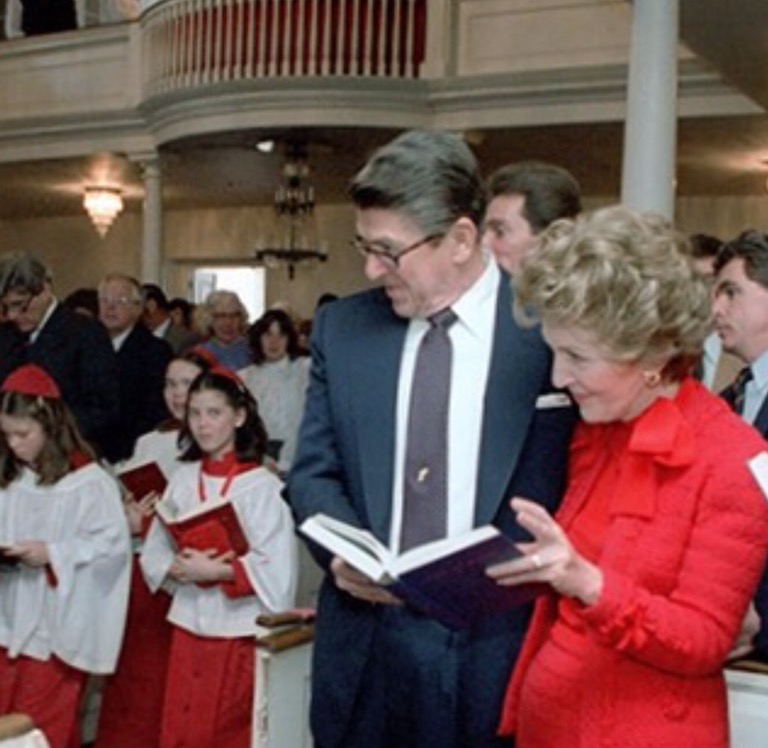Of all the presidential libraries, Reagan’s is the most stunning, perched above the Simi Valley in California, with amazing views in several directions. Apparently a herd of goats dutifully clears the mountain of vegetation that might burn during fire season. Most incredibly, the Air Force One that Reagan flew has been added to the library in its own breathtaking gallery overlooking the valley, as though flying Reagan to another summit.
The whole library is an homage to Reagan, the nation, the peaceful triumph of freedom in the Cold War, and the incredible trajectory of a boy from humble obscurity to historic greatness. Two days before visiting the Reagan site, I was at the Nixon Library. The two men had much in common, rising to power in post WWII California politics, both winning landslide reelections, both rising from near poverty and difficult families with undistinguished educational backgrounds to become global figures with notable foreign policy accomplishments.
But Reagan and Nixon were very different men. Nixon was an awkward introvert who struggled with small talk and seemingly contended against countless insecurities, despite his considerable intelligence and talent. He was happiest by himself in a den or hidden office with a book or his yellow legal pad. He prevailed in public life through steely discipline and grim determination, with forced smiles and clinched fists, often berating staffers as he strove to release his endless tension. His perspiration in the first debate with JFK may have lost him the presidency in 1960. As the Watergate tapes revealed, Nixon often expected the worst of people and spoke accordingly about them. After once meeting Reagan, he mercurially called the California governor “strange.” But Nixon was the odd one.
Reagan in contrast was largely serene, sunny, extroverted and optimistic. He rarely in private complained or disparaged others. His wife made it her mission to suspiciously protect her husband because he was, she thought, too trusting and accommodating. (She also after his near assassination turned to astrology, impatient with Reagan’s quiet faith.) Gorbachev remarked that Reagan’s demeanor projected all blue skies. Reagan inherited his outlook from his equally striving mother, who looked beyond her alcoholic husband and difficult finances to find endless avenues for good works and service to God. Like her son, she enjoyed the drama of the stage, literally and figuratively, and was confident that acting a good role could evolve into reality. Attitude leads to accomplishment.
The devout mother raised Reagan in her Disciples of Christ congregation, where he converted as an adolescent, taught Sunday school and was a lay preacher. The church was his first entrance into public life. Its pastor was his mentor, and his daughter was his first serious girlfriend. He seamlessly went to a denominational college, where he further excelled in student government and in public speaking. In later years he often lapsed in church attendance yet never seems to have struggled deeply with or questioned his childhood faith, which gave him a quiet confidence. The 1981 assassination attempt deepened his faith and providential purpose, as he confided to Washington’s Catholic archbishop.
Like Reagan, Nixon had a devout mother who raised him in the church, and while Quakerism deeply shaped him, he did not stick with its expectation of nonviolence and temperance, though he sought its promise of inner peace. If anything, his Quaker memory seems to have left Nixon with the anxiety of a troubled conscience in permanent tension with the political and geopolitical hardball that he sought to project.
The Nixon Library acknowledges his Quaker background but oddly the Reagan Library says little about his equally formative Disciples background. His mother’s Bible is displayed, noting he was sworn into office with it, but little is said about her strong religious influence. Instead his early athletic and drama accomplishments are emphasized. Reagan’s momentous funeral at National Cathedral is portrayed, but more for its stagecraft than its spirituality. A picture there shows his longtime Presbyterian pastor, who co-officiated.
The oversight of Reagan’s religion at his library means a large part of his core identity is left unexplained, which is sad and ironic, since, unlike Nixon, he was never shy about or reluctant to share it. Mount Vernon’s new museum recreates a pew from Washington’s church. Reagan’s library should recreate a pulpit or Sunday school table from his boyhood congregation.
No comments yet




